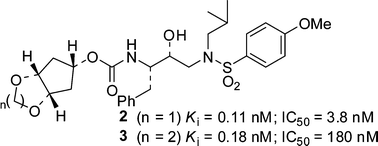Potent HIV-1protease inhibitors incorporating meso-bicyclic urethanes as P2-ligands: structure-based design, synthesis, biological evaluation and protein–ligand X-ray studies†
Abstract
Recently, we designed a series of novel

* Corresponding authors
a
Departments of Chemistry and Medicinal Chemistry, Purdue University, West Lafayette, USA
E-mail:
akghosh@purdue.edu
Fax: +1 765 4961612
Tel: +1 765 4945323
b Department of Biology, Molecular Basis of Disease, Georgia State University, Atlanta, USA
c Kumamoto University School of Medicine,
d Experimental Retrovirology Section, HIV and AIDS Malignancy Branch, National Cancer Institute, Bethesda, USA
Recently, we designed a series of novel

 Please wait while we load your content...
Something went wrong. Try again?
Please wait while we load your content...
Something went wrong. Try again?
A. K. Ghosh, S. Gemma, J. Takayama, A. Baldridge, S. Leshchenko-Yashchuk, H. B. Miller, Y. Wang, A. Y. Kovalevsky, Y. Koh, I. T. Weber and H. Mitsuya, Org. Biomol. Chem., 2008, 6, 3703 DOI: 10.1039/B809178A
To request permission to reproduce material from this article, please go to the Copyright Clearance Center request page.
If you are an author contributing to an RSC publication, you do not need to request permission provided correct acknowledgement is given.
If you are the author of this article, you do not need to request permission to reproduce figures and diagrams provided correct acknowledgement is given. If you want to reproduce the whole article in a third-party publication (excluding your thesis/dissertation for which permission is not required) please go to the Copyright Clearance Center request page.
Read more about how to correctly acknowledge RSC content.
 Fetching data from CrossRef.
Fetching data from CrossRef.
This may take some time to load.
Loading related content
